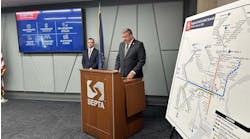Transit service levels remain steady as ridership takes hit from novel coronavirus
Transit systems across North America are largely maintaining their service levels, with a few exceptions, despite marked declines in ridership as social distancing ramped up in the U.S. and Canada within the past week as an added precaution to slow the spread of the novel coronavirus.
Systems in Toronto and St. Catherines, Ontario, Washington, D.C., Alexandria, Va., and the San Francisco Bay area have temporarily reduced service. However, other agencies remain open to the possibility of service reductions as they remain committed to providing critical service to their communities while heeding health department guidance and ensuring their networks are properly staffed.
Service reductions
In California, Caltrain will not offer its Baby Bullet Service during morning and afternoon peak hour service. Caltrain said local, limited and off-peak service will continue, but notes it will monitor ridership and adjust as needed. Caltrain’s operating costs are largely covered by fare revenue and the service provider says One-way and Day Pass tick sales have declined by approximately 75 percent from their levels two weeks ago.
Moving east, Washington Metropolitan Area Transit Authority escalated its Pandemic Flu Plan to Phase 3. Metrorail will operate during normal hours Monday-Sunday, but trains will operate every 12 minutes Monday-Saturday and every 15 minutes on Sundays. Depending on the line, Metrorail’s normal service operates every four to eight minutes during rush periods Monday-Friday and six to 12 minutes on Saturdays.
In neighboring Alexandria, Va., Alexandria Transit Company (DASH) will begin an “Enhanced Saturday” schedule on March 19. Weekend service levels will remain unchanged. All regular DASH routes will run on a Saturday schedule with additional trips provided on several routes to increase service frequencies, especially during weekday peak periods.
Additionally, Virginia Railway Express will run a "S" schedule on each of its two lines, Fredericksburg and Manassas, beginning March 17. The number of trains in service will go from 16 to eight - four inbound each morning and four outbound each afternoon.
Amtrak will operate approximately 40 percent of its typical weekday Northeast Corridor schedules, the Keystone Service will operate on a Saturday schedule between Harrisburg and Philadelphia, Penn., only and the Hartford Lind and Valley Flyer will operate on a Saturday schedule. Amtrak’s Maple Leaf and Adirondack service will also be reduced in New York State and the Winter Park Express is canceled for the rest of the season.
The Massachusetts Bay Transportation Authority (MBTA) will operate a reduced schedule of bus, commuter rail and subway services starting March 17. MBTA cancelled all ferry service but is maintaining regular service on six express bus routes and The RIDE, its paratransit service.
The Greensboro Transit Authority is running buses hourly as of March 16, which is close to half as many buses as it usually runs. The authority says this will allow for cleaning and sanitizing of the vehicles between runs.
In Ontario, Canada, St. Catharines Transit Commission will operate a Saturday schedule and Niagara Regional Transit service is unchanged.
Metrolinx will implement a temporary reduction in GO train and bus and UP Express service starting March 18. For GO trains, this means no express rush hour trains on Lakeshore East, Lakeshore West and Kitchener lines and the elimination of stops on others.
Other service reductions throughout North America were in response to announced school closings and universities moving classes online, making supplemental service for students no longer needed.
Ridership declines
Many transit agencies track monthly ridership numbers, but a handful of agencies have revealed preliminary numbers of their ridership decline since precautions against the novel coronavirus began to escalate. Like the decline in service above, it is hoped the ridership decline is also temporary.
Systems that have released numbers include:
- Bay Area Rapid Transit (BART) reports average daily ridership is down between 24 percent and 61 percent depending on the day. BART anticipates regular service through the week of March 16.
- King County Metro’s preliminary numbers shows the average bus ridership March 9-12 is down more than 36 percent compared to March 9-12, 2019. Water taxi ridership on March 12 was down more than 61 percent since March 2, 2020.
- The Philadelphia Inquirer reports the Southeastern Pennsylvania Transportation Authority’s ridership is down three percent and Port Authority Transit Corporation has experienced a six percent decline.
- New Jersey Transit’s preliminary review of its data indicates an approximate 20 percent reduction on both bus and rail ridership.
- Metropolitan Transportation Authority (MTA) ridership is down 18 percent on New York City Transit subways, 15 percent on bus, 31 percent on Long Island Rail Road and 48 percent on Metro-North Railroad compared to 2019 numbers.
MTA Chairman and CEO Patrick Foye spent the weekend appearing on several New York City news shows and reported the MTA system remains safe and noted the authority’s employees are showing up to work as they did in the aftermath of Sept. 11 and Superstorm Sandy.
“Employee availability is not an issue and transit workers and members of every one of our other unions are responding to the situation,” Foye said on Fox 5’s “Good Day New York” program March 13.
-----
This article was updated March 16, 1:00 pm to incorporate announcements from MBTA and VRE.

Mischa Wanek-Libman | Group Editorial Director
Mischa Wanek-Libman is director of communications with Transdev North America. She has more than 20 years of experience working in the transportation industry covering construction projects, engineering challenges, transit and rail operations and best practices.
Wanek-Libman has held top editorial positions at freight rail and public transportation business-to-business publications including as editor-in-chief and editorial director of Mass Transit from 2018-2024. She has been recognized for editorial excellence through her individual work, as well as for collaborative content.
She is an active member of the American Public Transportation Association's Marketing and Communications Committee and served 14 years as a Board Observer on the National Railroad Construction and Maintenance Association (NRC) Board of Directors.
She is a graduate of Drake University in Des Moines, Iowa, where she earned a Bachelor of Arts degree in Journalism and Mass Communication.




